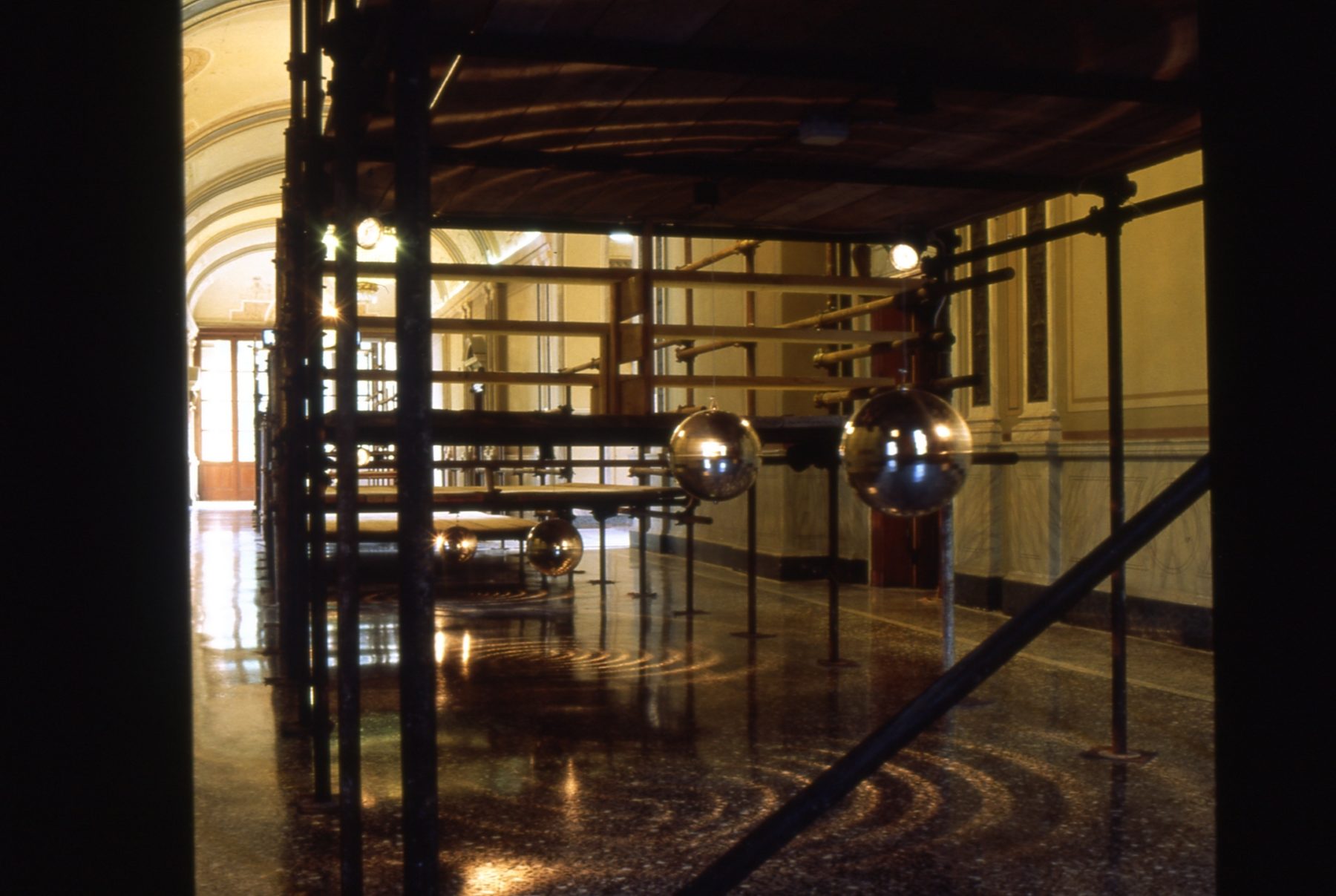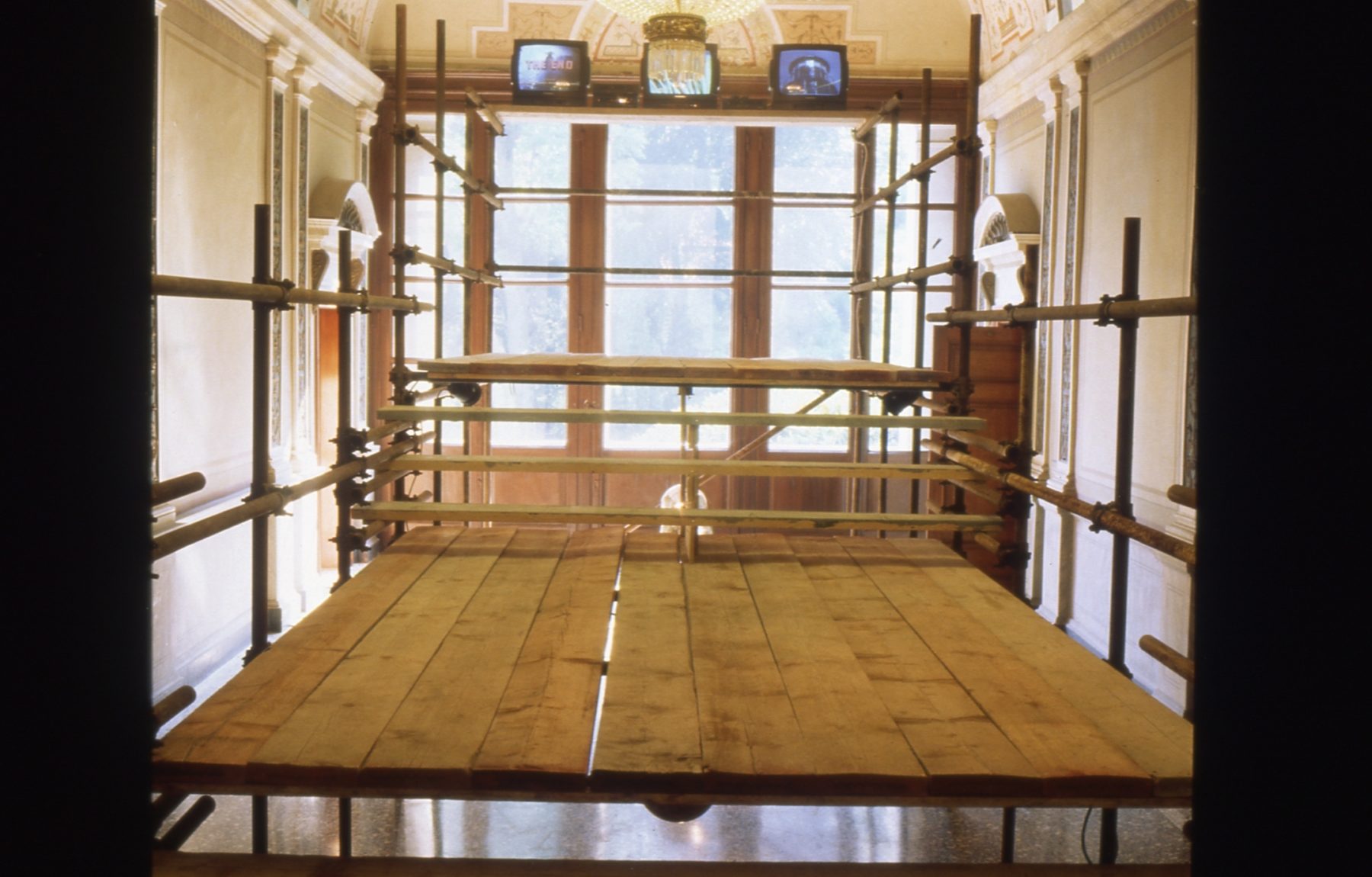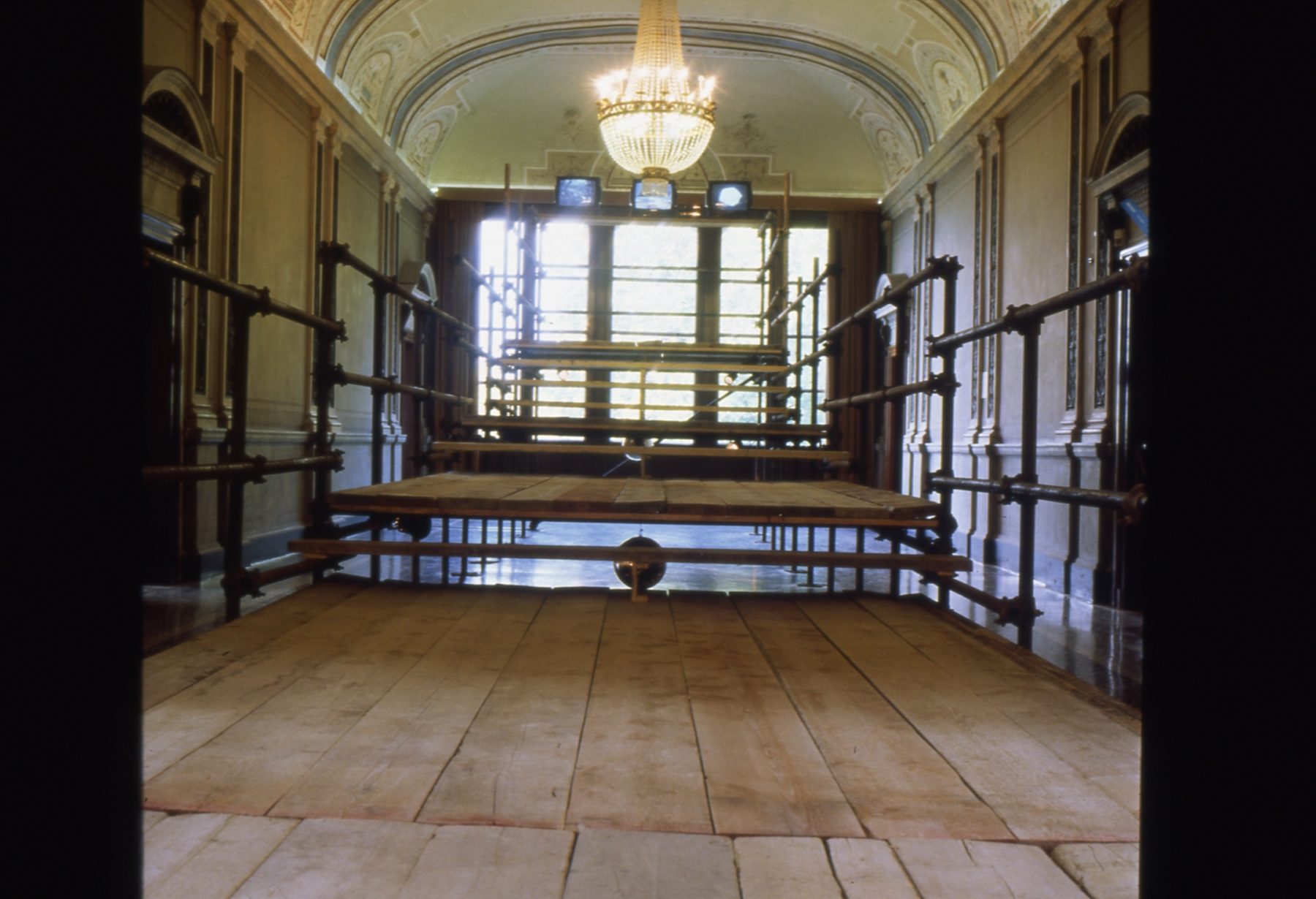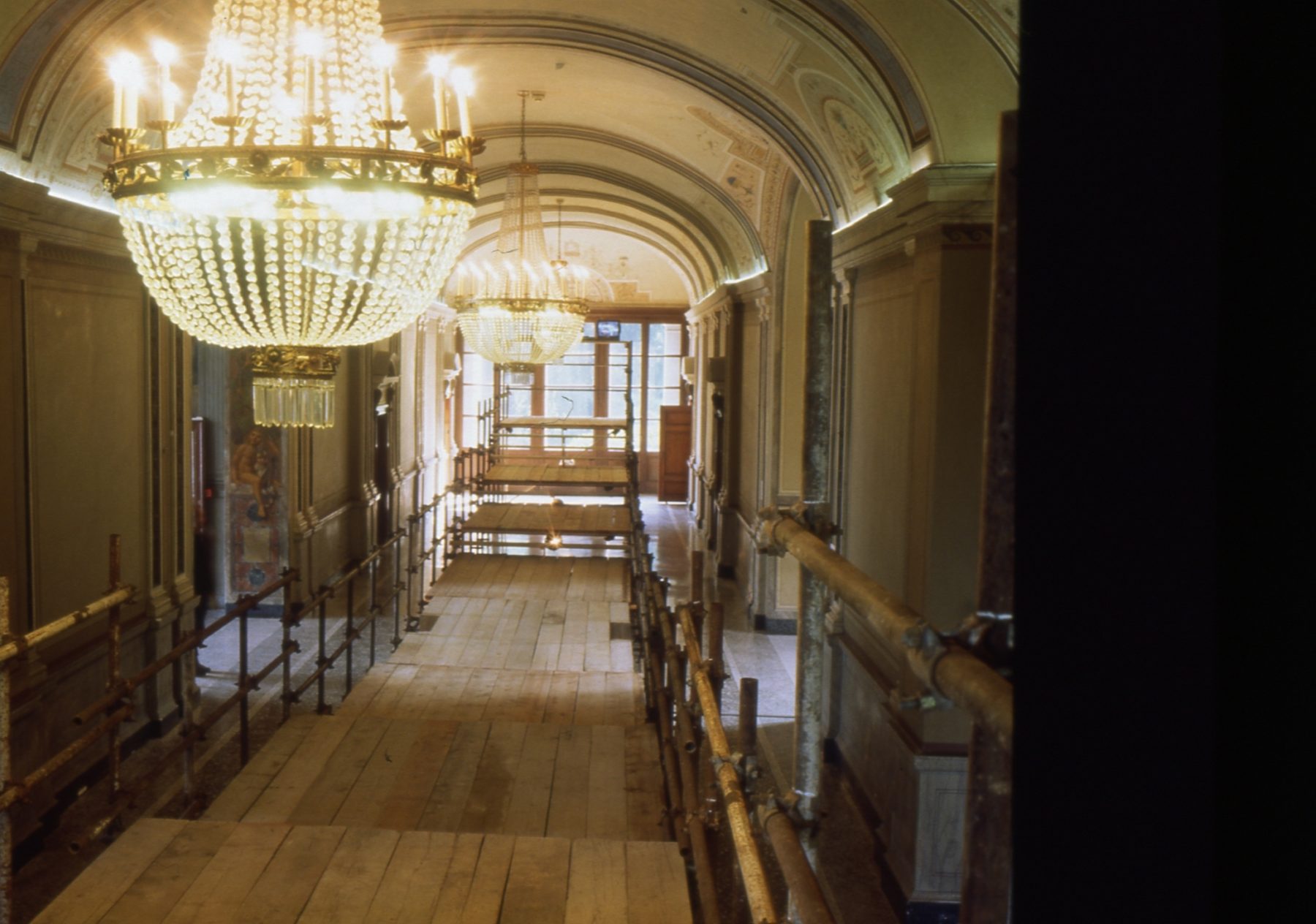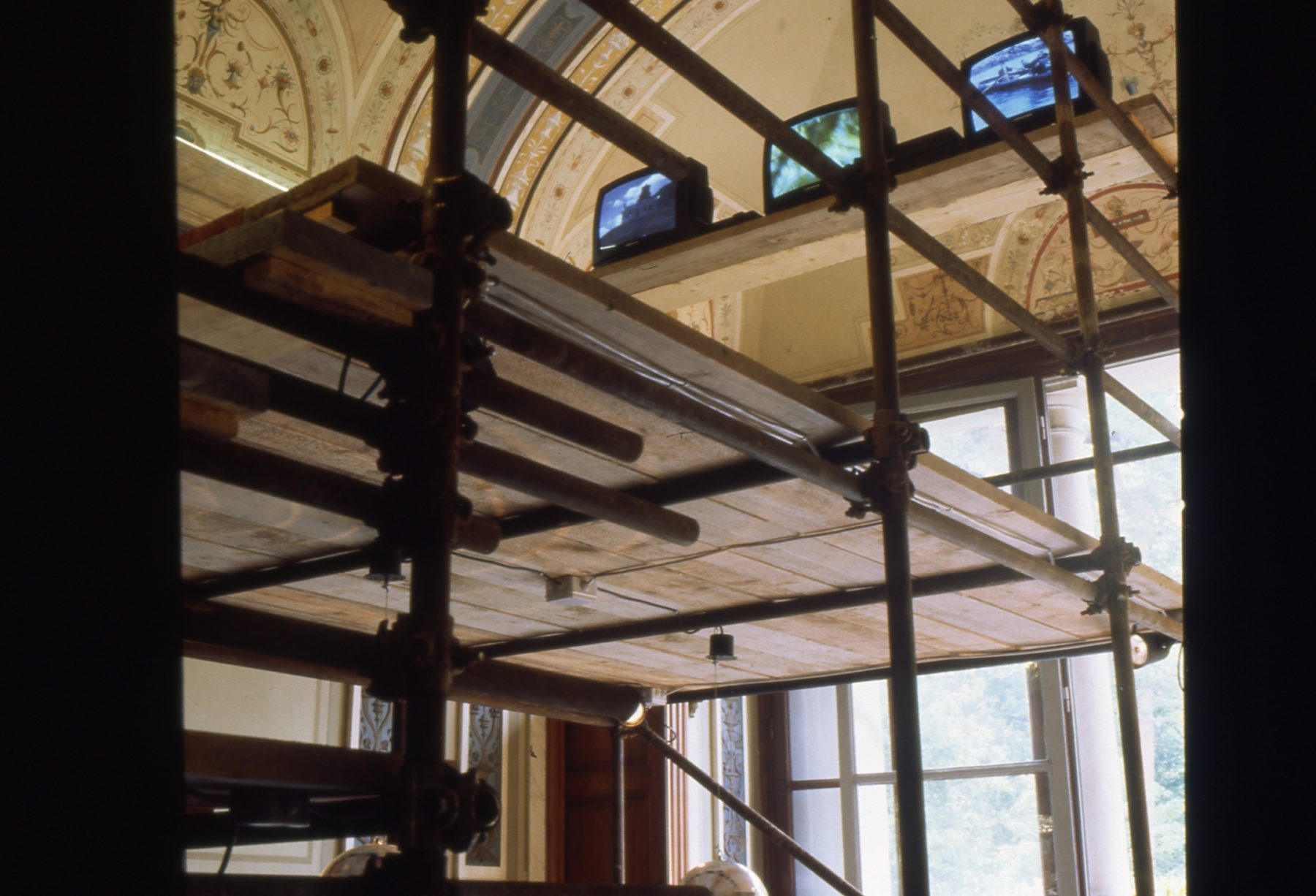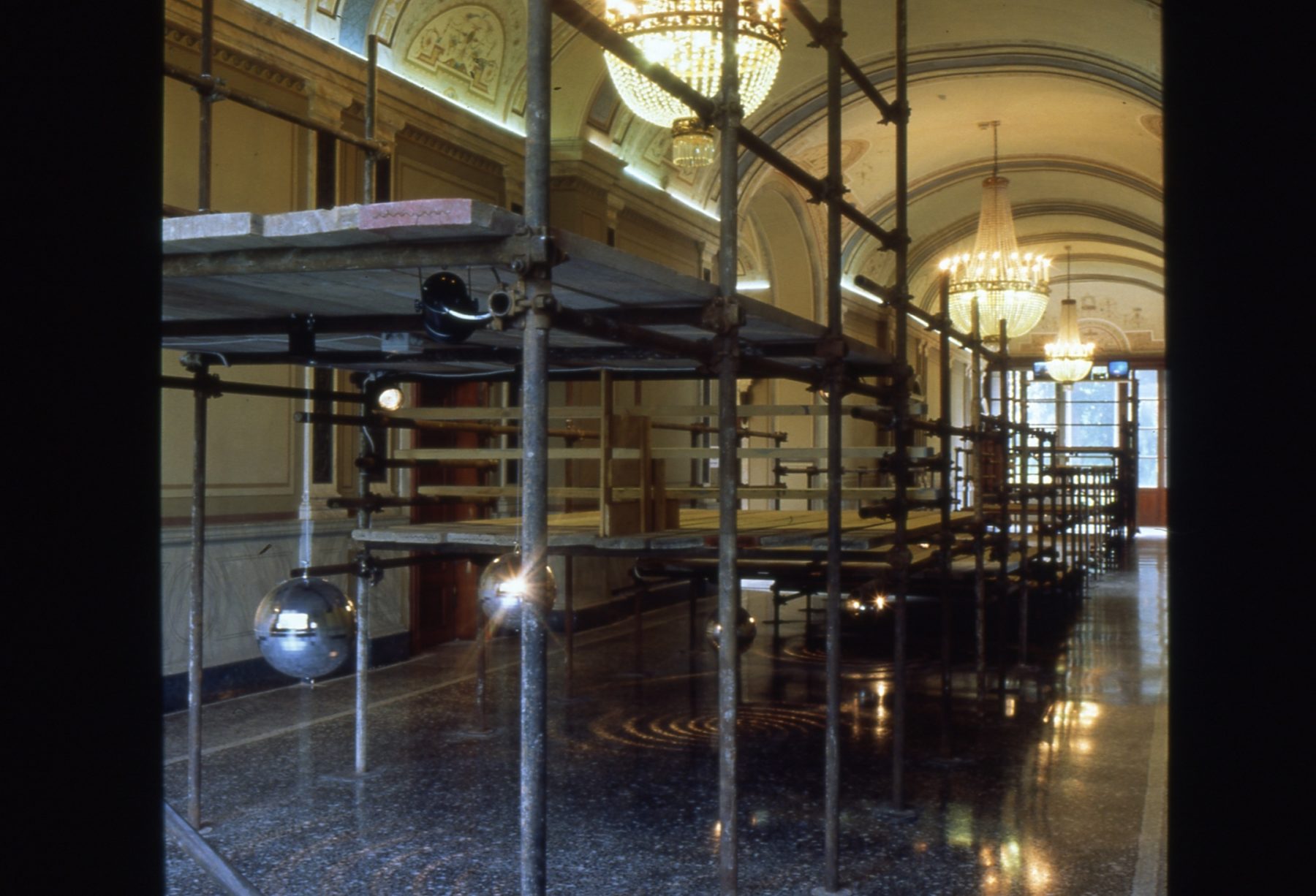John Armleder
The Botanical Speedboat Experience Inevitable
EXHIBITION
15 July–11 August 1996
Villa Carlotta
(Parker Williams meets John Armleder on the Shores of Lake Como. Summer 1996)
John Armleder, Parker Williams
Parker Williams: I am surprised about how you shuffled your previous scaffolding experiences around to fit them, or program them within the Villa Carlotta.
John Armleder: I was surprised myself about how the early version already anyway. But in fact, I am not sure what kind of a relationship they share.
PW: Well then, let's check the story. If I am right, you started a few years ago working on a construction planned for a show at the gallery Massimo De Carlo in Milan. The gallerist said you talked about a sort of Tatlin Tower (The Monument to the 3rd International), that one could walk into and climb up, but built in a clumsified Jessica Stockholder style... This did not happen there, but eventually was staged in a show at the Consortium in Dijon. The one in Milan was replaced by an almost invisible perspex construction of panels arranged into a floor based impenetrable shut labyrinth tower. In Dijon, you sent a documentation about Tatlin's project to the workers of the municipality for them to imagine how to build a three story level self-standing tower, using the scaffolding materials available. The piece, was ultimately planned to be used by the visitors, staging them in it as part of the system, and as they pursued their visit up the tower, a set of events would be available to them at different view levels. Paintings hung on the side, recto or verso, shelves had TV monitors showing a set of eight B movies of the Fifties and Sixties, S8 films were projected on the paintings and on the steps, disco-balls hung above and below the construction. Perspex sheets reflected asymmetrical mirror view of the architectonics of the proceeding, a battery of six ghettoblaster tape-decks were asyncromatically diffusing the whole works of the Mamas & Papas, and so on. The whole construction functioned as a funky vista-point for tourists that, from peek level, offered a view on a huge pour-painting hanging across on a wall, to be seen from above as an extravagant waterfall.
JA: Well, you got much of it, I see!
PW: Yes, I figure I should also mention the lights, fluorescent tubes at a diagonal following the steps leading to each floor (the only orthogonal element), the nests of flicking Christmas illumination lights arranged as strange knots, alien inflicted scars, plus the disco lights provided by the spotlights on the disco-balls, the scattered reflections they induce, the shivering lights diffused by the TV screens and the films projected, plus the music. Quite electronical all that.
JA: Ok, you got it somehow.
PW: This installation seemed somewhat more baroque than the one at the Villa Carlotta.
JA: This latter operation used similar devices into a different set of strategies. The earlier construction is based on a metaphorical procedure involving the related Tatlin model (modernist ideological epic), the post-modern elaboration (Stockholder), the panoramic vista-point (sculpture threshold pedestal for the viewer to gaze upon abstract paintings turned into landscape extravaganzas), all of this given to in the no-ties architectural stage of the white box contemporary art gallery setting. The focus was totally on the monster landed in the cipher space of the no-man's land of art-spiel. The use of kaleidoscopic memory technics, of abuse of pregiven sets and mental decors turn out being the most substantial event, undirected by any other purpose or production. In the Villa Carlotta production, the whole program is angled by an ambient foreplay. This foreplay is the intellectual, arousal of the happening, inasmuch as the sensual one.
PW: Wow! So I get why this is all so sexy. Glistening giant lizards, blowing rockets, spy speedboats, disco-globes, jungle greens and purple flowers, crystal chandeliers, Pompeian frescoes, suave ripples of the lake kissing the shores below the magnificent gardens...
JA: Let your mind behave! It seems that once that slurpy gate is opened, there is no way of calming you down.
PW: All right then. But after all, your pieces are quite physical, to the visitors that is. And the provided inputs quite sensual... So, tell me how this vessel of yours was designed?
JA: To land where it was to be experienced. The structure is a rough being. A sketch, a model and a usable vehicle as such, like a "MadMax" custom mechanic. It's mimetical to the formal architectonical proposals the hall provides. It's an unlikely bridge as in a jungle movie episode, but the leads are set within. One crosses from over the bridge that licks the floor to the three upper levels, step by step in a symmetrical mirror cast to face the TV monitors displaying an encapsulated escape.
PW: These are the cult movies and the two local tapes.
JA: The movies on the north side were wonders of mechanical inventions at play: flying saucers, rockets from outer space and Abbate speedboats. On the south promontory, the organic world lead the story with alien creatures rampaging, of giant batrahians and leafy greens wildly exposed in the Villa's gardens.
PW: That were filmed by you...
JA: The tape was a production shot for the exhibition by students of the summer course together with me.
PW: And what were the other films?
JA: The Organic program included The monster of Piedras Blancas and Gorgo, the spaceships side featuring This Island Earth, Earth Vs the Flying Saucers together with the Tullio Abbate demonstration tape.
PW: The spectator, having climbed up all the way, was engulfed in the ceiling's vault and its delicate Pompeian arabesques, and when facing the bay-windows had his view to the garden partially obliterated by the monitors (including one showing Abbate's boats on the lake observable outside, and another the gardens themselves also in direct sight); when turning to look back upon the room itself the chandeliers cleared away the unobstructed appreciation of the space. The visitor leaning and hopping to catch a glance at all sights... But, all that going on still left a fearly contemplative act to be experienced compared with the Dijon affair.
JA: Apart from other implications we often talked about, these works use in different ways an overloaded stream of information, of significations and events. Any evidence, all of them conglomerate in a jellified offering, with the characteristic translucid shine. Perhaps the earlier version was more opera-circus patterned as fancied by John Cage with congregations that remind me of Gottschalk. Talking about his Fàte champàtre cubaine he described composing a Triumphal Hymn and a Grand March: "My Orchestra consisted of 650 performers, 87 choristers, 15 solo singers, 50 drums, and 80 trumpets. That is to say nearly 900 persons bellowing and blowing to see who could scream the loudest. The violins alone were seventy in number, contrabasses eleven, violoncellos eleven!"
PW: I would have thought you'd relish on Gottschalk as a composer. He used to stage what he calls "Monster Concerts" after all!
JA: How could I resist a musician arranging the March from Tannhäuser for fourteen pianos! Furthermore, once a young patronized youth was imposed to him to play in such an ensemble, and obliged to let him play, Gottschalk had the mechanism of the piano removed by the tuner before the concert so that the young lad could play with all stamina his unnoticeably muted instrument among the thirteen other pianists...
PW: And I understand that in your view the pathetic agitation of that player was not a minor contribution to the meaning of the event. Talking about transcriptions, I should quote now in that perspective a former conversation we had in which you said the following: "The cartographers in the onirical land that Sylvie and Bruno wander throughout in Lewis Carroll's last fiction suffer to match with the fidelity they seek, the map transcriptions in small scale of the territories drafted. One is familiar with the tribulations that follow: the maps are made larger and larger finally matching the 1:1 scale of the land itself, and as the farmers angrily protest as their fields are shaded by the unfolding of the maps, the cartographers decide to use the actual ground as the map itself. So to say, reality understood as a transcription. Now the step today probably implies that reality doesn't match itself. Our planet is not itself anymore. It's no more the Earth. We use it for other purposes. It is a set for shooting B series. Finally! We should carefully watch the parachutist in all the Killer Tomatoes sequels as he demonstrates an unheard version of Art as a prothesis, a picaresque prothesis as a wreck." (in Che fare? Never Say Never, Offizin Verlag, Zürich 1996). I believe the story has still a romantic punch since you display festive "plateaux" as extravagant features and provide dissoluting mediums for evanescent seizures.
JA: Here you go again!
PW: I must run to catch.
JA: In a porridge world, running stops you, sinks you like in quicksands. You'd be better beaming your mind into its marshmallow condition and then float around to enjoy: aren't earthlings just yet some innocent planetoids in storage for fun adventures...
